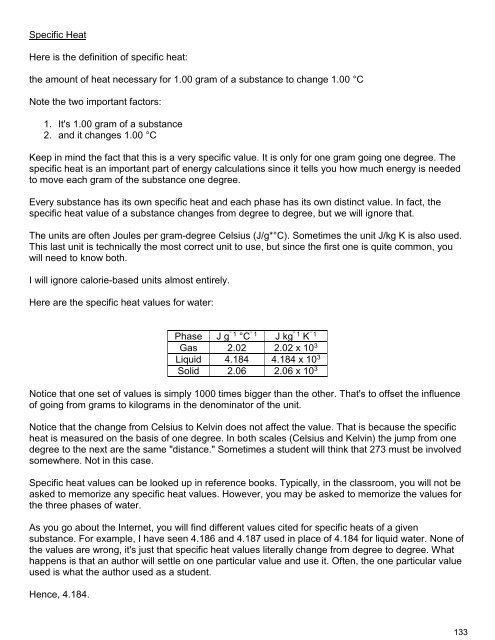(FINAL) Chemistry Notebook 2016-17
- No tags were found...
You also want an ePaper? Increase the reach of your titles
YUMPU automatically turns print PDFs into web optimized ePapers that Google loves.
Specific Heat<br />
Here is the definition of specific heat:<br />
the amount of heat necessary for 1.00 gram of a substance to change 1.00 °C<br />
Note the two important factors:<br />
1. It's 1.00 gram of a substance<br />
2. and it changes 1.00 °C<br />
Keep in mind the fact that this is a very specific value. It is only for one gram going one degree. The<br />
specific heat is an important part of energy calculations since it tells you how much energy is needed<br />
to move each gram of the substance one degree.<br />
Every substance has its own specific heat and each phase has its own distinct value. In fact, the<br />
specific heat value of a substance changes from degree to degree, but we will ignore that.<br />
The units are often Joules per gram-degree Celsius (J/g*°C). Sometimes the unit J/kg K is also used.<br />
This last unit is technically the most correct unit to use, but since the first one is quite common, you<br />
will need to know both.<br />
I will ignore calorie-based units almost entirely.<br />
Here are the specific heat values for water:<br />
Phase J g¯1 °C¯1 J kg¯1<br />
K¯1<br />
Gas 2.02 2.02 x 10 3<br />
Liquid 4.184 4.184 x 10 3<br />
Solid 2.06 2.06 x 10 3<br />
Notice that one set of values is simply 1000 times bigger than the other. That's to offset the influence<br />
of going from grams to kilograms in the denominator of the unit.<br />
Notice that the change from Celsius to Kelvin does not affect the value. That is because the specific<br />
heat is measured on the basis of one degree. In both scales (Celsius and Kelvin) the jump from one<br />
degree to the next are the same "distance." Sometimes a student will think that 273 must be involved<br />
somewhere. Not in this case.<br />
Specific heat values can be looked up in reference books. Typically, in the classroom, you will not be<br />
asked to memorize any specific heat values. However, you may be asked to memorize the values for<br />
the three phases of water.<br />
As you go about the Internet, you will find different values cited for specific heats of a given<br />
substance. For example, I have seen 4.186 and 4.187 used in place of 4.184 for liquid water. None of<br />
the values are wrong, it's just that specific heat values literally change from degree to degree. What<br />
happens is that an author will settle on one particular value and use it. Often, the one particular value<br />
used is what the author used as a student.<br />
Hence, 4.184.<br />
133





